电子科技大学:《汉外语言对比研究 Compative Study of Chinese and Foreign Languages》课程教学资源(课件讲稿)Chapter 05 Overtness and Covertness

Chapter 5 Overtness and Covertness
Chapter 5 Overtness and Covertness
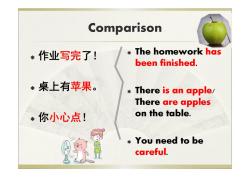
Comparison *作业写完了! The homework has been finished. *桌上有苹果。 There is an apple/ There are apples *你小心点! on the table. You need to be careful
Comparison 作业写完了! 桌上有苹果。 你小心点! The homework has been finished. There is an apple/ There are apples on the table. You need to be careful
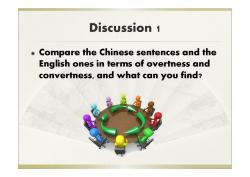
Discussion 1 Compare the Chinese sentences and the English ones in terms of overtness and convertness,and what can you find?
Discussion 1 Compare the Chinese sentences and the English ones in terms of overtness and convertness, and what can you find?
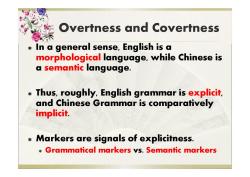
Overtness and Covertness In a general sense,English is a morphological language,while Chinese is semantic language. Thus,roughly,English grammar is explicit, and Chinese Grammar is comparatively implicit. 米 Markers are signals of explicitness. Grammatical markers vs.Semantic markers
Overtness and Covertness In a general sense, English is a morphological language, while Chinese is a semantic language. Thus, roughly, English grammar is explicit, and Chinese Grammar is comparatively implicit. Markers are signals of explicitness. Grammatical markers vs. Semantic markers

Discussion 2 Can you work out some grammatical and semantic markers that distinguish English and Chinese in terms of overtness and covertness?
Discussion 2 Can you work out some grammatical and semantic markers that distinguish English and Chinese in terms of overtness and covertness?
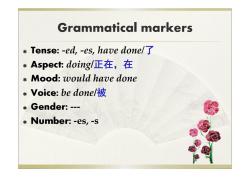
Grammatical markers Tense:-ed,-es,have done/ *Aspect:doing/正在,在 米 Mood:would have done *Voice:be done/被 Gender:--- Number:-es,-s
Tense: -ed, -es, have done/了 Aspect: doing/正在,在 Mood: would have done Voice: be done/被 Gender: --- Number: -es, -s Grammatical markers
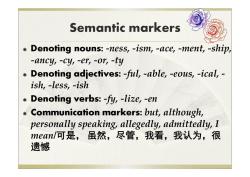
Semantic markers Denoting nouns:-ness,-ism,-ace,-ment,-ship, -ancy,-cy,-er,-or,-ty Denoting adjectives:-ful,-able,-eous,-ical, ish,-less,-ish Denoting verbs:-fy,-lize,-en Communication markers:but,although, personally speaking,allegedly,admittedly,I mean/可是,虽然,尽管,我看,我认为,很 遗憾
Denoting nouns: -ness, -ism, -ace, -ment, -ship, -ancy, -cy, -er, -or, -ty Denoting adjectives: -ful, -able, -eous, -ical, - ish, -less, -ish Denoting verbs: -fy, -lize, -en Communication markers: but, although, personally speaking, allegedly, admittedly, I mean/可是, 虽然,尽管,我看,我认为,很 遗憾 Semantic markers
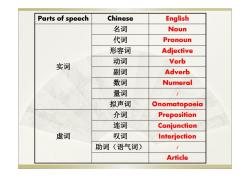
Parts of speech Chinese English 名词 Noun 代词 Pronoun 形容词 Adjective 动词 Verb 实词 副词 Adverb 数词 Numeral 量词 拟声词 Onomatopoeia 介词 Preposition 连词 Conjunction 虚词 叹词 Interjection 助词(语气词) Article
Parts of speech Chinese English 实词 名词 Noun 代词 Pronoun 形容词 Adjective 动词 Verb 副词 Adverb 数词 Numeral 量词 / 拟声词 Onomatopoeia 虚词 介词 Preposition 连词 Conjunction 叹词 Interjection 助词(语气词) / Article
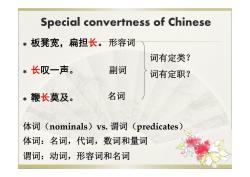
Special convertness of Chinese *板凳宽,扁担长。形容词 词有定类? *长叹一声。 副词 词有定职? *鞭长莫及。 名词 体词(nominals)vs.谓词(predicates) 体词:名词,代词,数词和量词 谓词:动词,形容词和名词
Special convertness of Chinese 板凳宽,扁担长。 长叹一声。 鞭长莫及。 形容词 副词 名词 词有定类? 词有定职? 体词(nominals)vs. 谓词(predicates) 体词:名词,代词,数词和量词 谓词:动词,形容词和名词

Special convertness of Chinese Chinese has no clear cuts between parts of speech
Chinese has no clear cuts between parts of speech. Special convertness of Chinese
按次数下载不扣除下载券;
注册用户24小时内重复下载只扣除一次;
顺序:VIP每日次数-->可用次数-->下载券;
- 电子科技大学:《汉外语言对比研究 Compative Study of Chinese and Foreign Languages》课程教学资源(课件讲稿)Chapter 04 Stativeness and Dynamicity.pdf
- 电子科技大学:《汉外语言对比研究 Compative Study of Chinese and Foreign Languages》课程教学资源(课件讲稿)Chapter 03 Conception and Nomenclature transitivity.pdf
- 电子科技大学:《汉外语言对比研究 Compative Study of Chinese and Foreign Languages》课程教学资源(课件讲稿)Chapter 02 Conception and Nomenclature.pdf
- 电子科技大学:《汉外语言对比研究 Compative Study of Chinese and Foreign Languages》课程教学资源(课件讲稿)Chapter 01 A general comparison(袁毅敏).pdf
- 电子科技大学:《博士研究生英语 English for PhD Candidates》课程教学资源(教学大纲).pdf
- 电子科技大学:《非文学翻译 Non-literary Translation》课程教学资源(课件讲稿,共十二章).pdf
- 电子科技大学:《非文学翻译 Non-literary Translation》课程教学资源(小组协作翻译总结报告)“照片”工具使用指南(本地化翻译).pdf
- 电子科技大学:《非文学翻译 Non-literary Translation》课程教学资源(教学大纲,林何).pdf
- 电子科技大学:《翻译类论文写作》课程教学课件讲稿(Thesis Writing about Translation)要件写法(廖敏).pdf
- 电子科技大学:《翻译类论文写作》课程教学课件讲稿(Thesis Writing about Translation)翻译报告写作版块——八大版块写作.pdf
- 电子科技大学:《翻译类论文写作》课程教学课件讲稿(Thesis Writing about Translation)报告类详解(备用)实践、项目、实验.pdf
- 电子科技大学:《翻译类论文写作》课程教学课件讲稿(Thesis Writing about Translation)过程、选题与模版.pdf
- 电子科技大学:《翻译类论文写作》课程教学课件讲稿(Thesis Writing about Translation)方案与要求.pdf
- 电子科技大学:《通用英语B(提高)College English B(Intermediate)》课程教学资源(课件讲稿)Unit 01.pdf
- 电子科技大学:《通用英语B(提高)College English B(Intermediate)》课程教学资源(思政案例).pdf
- 电子科技大学:《通用英语B(提高)College English B(Intermediate)》课程教学资源(教学大纲).pdf
- 对外经济贸易大学:《商务英语》课程教学资源(授课教案)Chapter 5 What Is International Business?.pdf
- 《儿童英语》课程教学资源(教学教案)动词不规则变化 Irregular verbs.docx
- 《儿童英语》课程教学资源(教学教案)儿童英语小组学习提纲.docx
- 长沙医学院:外国语学院课程简介.pdf
- 电子科技大学:《汉外语言对比研究 Compative Study of Chinese and Foreign Languages》课程教学资源(课件讲稿)Chapter 06 Rigidity and Flexibility.pdf
- 电子科技大学:《汉外语言对比研究 Compative Study of Chinese and Foreign Languages》课程教学资源(课件讲稿)Chapter 07 Objectivity and subjectivity.pdf
- 电子科技大学:《汉外语言对比研究 Compative Study of Chinese and Foreign Languages》课程教学资源(课件讲稿)Chapter 08 Abstraction and Concretion.pdf
- 山西师范大学:《对照语言学》课程教学大纲(日语专业).pdf
- 山西师范大学:《日语演讲技巧训练》课程教学大纲(日语专业).pdf
- 山西师范大学:《古典语法讲座》课程教学大纲(日语专业).pdf
- 山西师范大学:《日本历史》课程教学大纲(日语专业).pdf
- 山西师范大学:《综合日语》课程教学大纲(日语专业).pdf
- 山西师范大学:《中学日语综合实践活动》课程教学大纲(日语专业).pdf
- 山西师范大学:《中学日语课程标准与教材研究》课程教学大纲(日语专业).pdf
- 山西师范大学:《中学日语教学设计》课程教学大纲(日语专业).pdf
- 山西师范大学:《现代日语口语语法》课程教学大纲(日语专业).pdf
- 山西师范大学:《视听说》课程教学大纲(日语专业).pdf
- 山西师范大学:《商务日语》课程教学大纲(日语专业).pdf
- 山西师范大学:《日语阅读》课程教学大纲(日语专业).pdf
- 山西师范大学:《日语写作》课程教学大纲(日语专业).pdf
- 山西师范大学:《日语音调》课程教学大纲(日语专业).pdf
- 山西师范大学:《日语网络新闻阅读》课程教学大纲(日语专业).pdf
- 山西师范大学:《日语听力》课程教学大纲(日语专业).pdf
- 山西师范大学:《日语口语》课程教学大纲(日语专业).pdf
